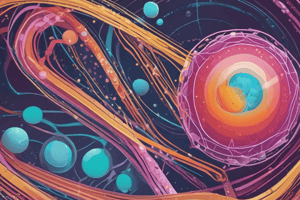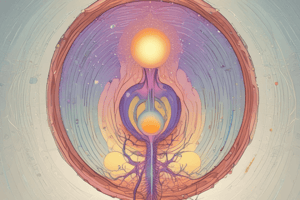Podcast
Questions and Answers
Which of the following events is primarily responsible for beginning the metabolic processes in the egg after fertilization?
Which of the following events is primarily responsible for beginning the metabolic processes in the egg after fertilization?
- Regulation of sperm entry into the egg
- Activation of egg metabolism to start development (correct)
- Fusion of genetic material from the two gametes
- Contact and recognition between sperm and egg
What role does the fusion of genetic material play in the process of fertilization?
What role does the fusion of genetic material play in the process of fertilization?
- It provides the necessary genetic information for the embryo. (correct)
- It allows for the regulation of sperm entry.
- It determines the sex of the embryo.
- It initiates the metabolic activities of the egg.
What is the first step of the fertilization process amongst the listed events?
What is the first step of the fertilization process amongst the listed events?
- Contact and recognition between sperm and egg (correct)
- Fusion of genetic material from the two gametes
- Activation of egg metabolism to start development
- Regulation of sperm entry into the egg
Which event directly controls how sperm is allowed entry into the egg?
Which event directly controls how sperm is allowed entry into the egg?
Which of the following statements correctly describes an outcome of the fertilization events?
Which of the following statements correctly describes an outcome of the fertilization events?
What is the primary role of exocytosis in sperm function?
What is the primary role of exocytosis in sperm function?
Which component does the sperm bind to during fertilization?
Which component does the sperm bind to during fertilization?
What process follows the sperm binding to the zona pellucida?
What process follows the sperm binding to the zona pellucida?
What is the function of enzymes released by the sperm's acrosomal vesicle?
What is the function of enzymes released by the sperm's acrosomal vesicle?
What must occur before the sperm can pass through the extracellular matrix of the egg?
What must occur before the sperm can pass through the extracellular matrix of the egg?
What is the primary function of the extracellular layer surrounding the egg cell membrane?
What is the primary function of the extracellular layer surrounding the egg cell membrane?
Which of the following describes the extracellular layer found in most mammals?
Which of the following describes the extracellular layer found in most mammals?
Which statement is true about the vitelline envelope?
Which statement is true about the vitelline envelope?
What is the main difference between the zona pellucida and the vitelline envelope?
What is the main difference between the zona pellucida and the vitelline envelope?
Which function is NOT associated with the extracellular layer surrounding the egg cell membrane?
Which function is NOT associated with the extracellular layer surrounding the egg cell membrane?
What initiates sperm motility during fertilization?
What initiates sperm motility during fertilization?
What is the purpose of the resact gradient in fertilization?
What is the purpose of the resact gradient in fertilization?
What occurs during the acrosome reaction?
What occurs during the acrosome reaction?
Which of the following statements about the acrosome reaction is correct?
Which of the following statements about the acrosome reaction is correct?
Which of the following is NOT involved in the initial approach of sperm to the egg?
Which of the following is NOT involved in the initial approach of sperm to the egg?
What primarily causes the fast block to polyspermy in sea urchin eggs?
What primarily causes the fast block to polyspermy in sea urchin eggs?
What is the outcome of the lethality caused by blastomeres with different chromosome numbers in sea urchins?
What is the outcome of the lethality caused by blastomeres with different chromosome numbers in sea urchins?
What is the result of the egg membrane's resting potential rising?
What is the result of the egg membrane's resting potential rising?
Which of the following mechanisms is considered a fast block to polyspermy?
Which of the following mechanisms is considered a fast block to polyspermy?
Which of the following statements is true regarding polyspermy prevention in sea urchins?
Which of the following statements is true regarding polyspermy prevention in sea urchins?
What occurs immediately after the fusion of the male and female pronuclei in sea urchins?
What occurs immediately after the fusion of the male and female pronuclei in sea urchins?
Which statement accurately describes the status of the zygote immediately after the fusion of the pronuclei?
Which statement accurately describes the status of the zygote immediately after the fusion of the pronuclei?
In sea urchins, what is the sequence of events after pronuclear fusion?
In sea urchins, what is the sequence of events after pronuclear fusion?
Which best describes the outcome of pronuclear fusion in sea urchins?
Which best describes the outcome of pronuclear fusion in sea urchins?
What is the significance of DNA replication occurring after the fusion of pronuclei in sea urchins?
What is the significance of DNA replication occurring after the fusion of pronuclei in sea urchins?
Flashcards
Sperm-Egg Recognition
Sperm-Egg Recognition
The first step in fertilization, involving the sperm recognizing and attaching to the egg.
Sperm Entry Regulation
Sperm Entry Regulation
The process of ensuring only one sperm enters the egg, preventing polyspermy.
Fusion of Genetic Material
Fusion of Genetic Material
The merging of the sperm and egg's genetic material, forming a single cell called a zygote.
Egg Activation
Egg Activation
Signup and view all the flashcards
Fertilization
Fertilization
Signup and view all the flashcards
Extracellular Layer
Extracellular Layer
Signup and view all the flashcards
Vitelline Envelope
Vitelline Envelope
Signup and view all the flashcards
Zona Pellucida
Zona Pellucida
Signup and view all the flashcards
Sperm Recognition
Sperm Recognition
Signup and view all the flashcards
Acrosomal Reaction
Acrosomal Reaction
Signup and view all the flashcards
Sperm Binding
Sperm Binding
Signup and view all the flashcards
Sperm Penetration
Sperm Penetration
Signup and view all the flashcards
Sperm-Egg Fusion
Sperm-Egg Fusion
Signup and view all the flashcards
Sperm Motility Activation
Sperm Motility Activation
Signup and view all the flashcards
Resact Gradient
Resact Gradient
Signup and view all the flashcards
Second Interaction
Second Interaction
Signup and view all the flashcards
Fast Block to Polyspermy
Fast Block to Polyspermy
Signup and view all the flashcards
Sodium Ion Influx
Sodium Ion Influx
Signup and view all the flashcards
Egg Membrane Potential Change
Egg Membrane Potential Change
Signup and view all the flashcards
Temporary Block
Temporary Block
Signup and view all the flashcards
Polypermy and Lethality
Polypermy and Lethality
Signup and view all the flashcards
Pronuclear Fusion
Pronuclear Fusion
Signup and view all the flashcards
DNA Replication after Fusion
DNA Replication after Fusion
Signup and view all the flashcards
Diploid Zygote
Diploid Zygote
Signup and view all the flashcards
Sea Urchin Fertilization
Sea Urchin Fertilization
Signup and view all the flashcards
Pronuclear Fusion in Sea Urchins
Pronuclear Fusion in Sea Urchins
Signup and view all the flashcards
Study Notes
Developmental Biology Lecture 10: Fertilization
- Fertilization: Two main functions:
- Combining genetic material from two parents (sex)
- Creating a new organism (reproduction)
- Fertilization process (general):
- Contact and recognition between sperm and egg
- Sperm entry regulation into the egg
- Fusion of genetic material from both gametes
- Egg metabolism activation for development
Sperm Structure
- Head: Contains a haploid nucleus and acrosome.
- Acrosome: Derived from Golgi apparatus, contains enzymes to digest egg's extracellular coats.
- Midpiece: Contains mitochondria and centriole that produces flagellum microtubules.
- Tail: Provides energy for movement using mitochondrial ATP.
Egg Structure
- Large cytoplasm: Stores ribosomes, nutritive proteins, and morphogenetic factors.
- Protective agents: Present for survival in the specific environment.
- Extracellular layers: Surround the egg's cell membrane, involved in sperm recognition; examples include vitelline envelope (most animals) and the zona pellucida (mammals).
Egg and Sperm Recognition
- Five steps:
- Chemoattraction of sperm to egg through soluble molecules secreted by the egg.
- Exocytosis of sperm acrosomal vesicle and enzyme release.
- Sperm binding to egg's extracellular matrix (like vitelline envelope or zona pellucida).
- Sperm passage through the extracellular matrix.
- Fusion of egg and sperm cell membranes.
External Fertilization in Sea Urchins
- Steps:
- Sperm contacts egg jelly layer
- Acrosome reaction
- Jelly layer digestion
- Binding to vitelline envelope
- Fusion of acrosomal process and egg membrane
Sperm Attraction
- Chemotaxis: Sperm attracted by egg-secreted chemicals (like resact and speract in sea urchins).
- Activation: Specific peptides (chemoattractants) increase sperm motility, providing directional movement.
- Resact: Binds to sperm receptors; Leads to calcium channel opening; Activates sperm motility and directs it to the egg.
Acrosome Reaction
- Two components:
- Fusion of acrosomal vesicle with sperm cell membrane (exocytosis), releasing contents.
- Extension of acrosomal process using globular actin to reach and fuse with the egg cell membrane.
- Proteolytic enzymes: Released to digest protective egg coating, ensuring sperm access.
Bindin
- Recognition: A protein on the sperm's acrosomal process recognized by protein complex on sea urchin egg's surface.
- Gamete mediation: May be involved in gamete recognition and fusion in sea urchins.
One Egg, One Sperm (Monospermy)
- Normal fertilization: Entry of only one sperm into the egg.
- Polyspermy: Entry of two or more sperm, usually lethal.
- Fast block: Change in the egg cell membrane's electrical potential (sodium influx) preventing further sperm entry (1-3 seconds).
- Slow block: Cortical granules react with egg cell membrane, altering the vitelline envelope, creating the fertilization envelope, and preventing polyspermy.
Fusion of Genetic Material in Sea Urchins
- Pronuclei: Male and female pronuclei carrying genetic material migrate and fuse.
- Zygote nucleus formation: A diploid zygote nucleus formed by the merging of pronuclei.
- DNA replication: Occurs after pronuclear fusion.
Studying That Suits You
Use AI to generate personalized quizzes and flashcards to suit your learning preferences.




